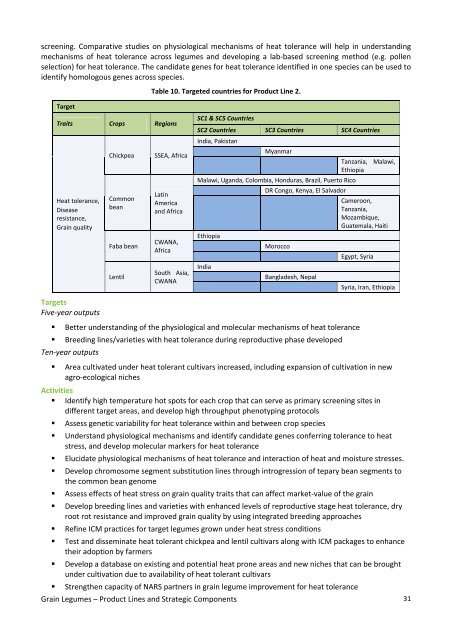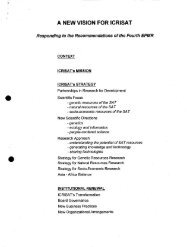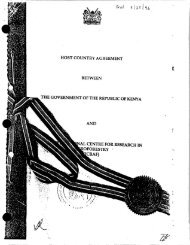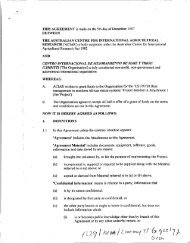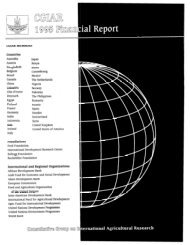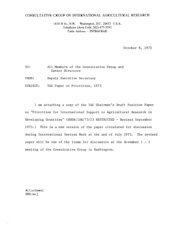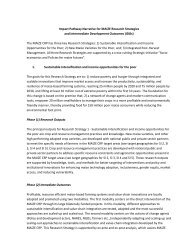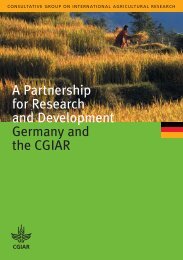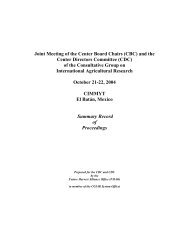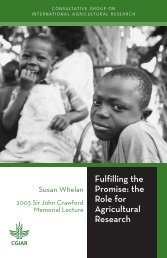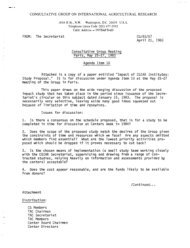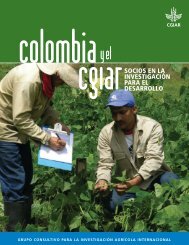CGIAR Research Program on Grain Legumes: Proposal - Library
CGIAR Research Program on Grain Legumes: Proposal - Library
CGIAR Research Program on Grain Legumes: Proposal - Library
- No tags were found...
Create successful ePaper yourself
Turn your PDF publications into a flip-book with our unique Google optimized e-Paper software.
screening. Comparative studies <strong>on</strong> physiological mechanisms of heat tolerance will help in understandingmechanisms of heat tolerance across legumes and developing a lab-based screening method (e.g. pollenselecti<strong>on</strong>) for heat tolerance. The candidate genes for heat tolerance identified in <strong>on</strong>e species can be used toidentify homologous genes across species.TargetTable 10. Targeted countries for Product Line 2.Traits Crops Regi<strong>on</strong>sHeat tolerance,Diseaseresistance,<strong>Grain</strong> qualityChickpeaComm<strong>on</strong>beanFaba beanLentilSSEA, AfricaLatinAmericaand AfricaCWANA,AfricaSouth Asia,CWANASC1 & SC5 CountriesSC2 Countries SC3 Countries SC4 CountriesIndia, PakistanMyanmarMalawi, Uganda, Colombia, H<strong>on</strong>duras, Brazil, Puerto RicoEthiopiaIndiaDR C<strong>on</strong>go, Kenya, El SalvadorMoroccoBangladesh, NepalTanzania, Malawi,EthiopiaCamero<strong>on</strong>,Tanzania,Mozambique,Guatemala, HaitiEgypt, SyriaSyria, Iran, EthiopiaTargetsFive-year outputs• Better understanding of the physiological and molecular mechanisms of heat tolerance• Breeding lines/varieties with heat tolerance during reproductive phase developedTen-year outputs• Area cultivated under heat tolerant cultivars increased, including expansi<strong>on</strong> of cultivati<strong>on</strong> in newagro-ecological nichesActivities• Identify high temperature hot spots for each crop that can serve as primary screening sites indifferent target areas, and develop high throughput phenotyping protocols• Assess genetic variability for heat tolerance within and between crop species• Understand physiological mechanisms and identify candidate genes c<strong>on</strong>ferring tolerance to heatstress, and develop molecular markers for heat tolerance• Elucidate physiological mechanisms of heat tolerance and interacti<strong>on</strong> of heat and moisture stresses.• Develop chromosome segment substituti<strong>on</strong> lines through introgressi<strong>on</strong> of tepary bean segments tothe comm<strong>on</strong> bean genome• Assess effects of heat stress <strong>on</strong> grain quality traits that can affect market-value of the grain• Develop breeding lines and varieties with enhanced levels of reproductive stage heat tolerance, dryroot rot resistance and improved grain quality by using integrated breeding approaches• Refine ICM practices for target legumes grown under heat stress c<strong>on</strong>diti<strong>on</strong>s• Test and disseminate heat tolerant chickpea and lentil cultivars al<strong>on</strong>g with ICM packages to enhancetheir adopti<strong>on</strong> by farmers• Develop a database <strong>on</strong> existing and potential heat pr<strong>on</strong>e areas and new niches that can be broughtunder cultivati<strong>on</strong> due to availability of heat tolerant cultivars• Strengthen capacity of NARS partners in grain legume improvement for heat tolerance<strong>Grain</strong> <strong>Legumes</strong> – Product Lines and Strategic Comp<strong>on</strong>ents 31


